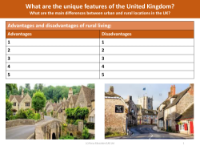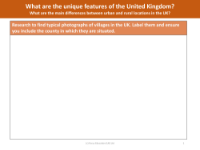What are the main differences between urban and rural locations in the UK? - Presentation

Geography Resource Description
The United Kingdom exhibits distinct characteristics in its urban and rural locations, each offering unique features and lifestyles. In educational resources designed to explore these differences, students are encouraged to investigate the main features of villages, towns, and cities. Villages, typically found in rural areas, are smaller in size and often characterized by a close-knit community, open spaces, and a slower pace of life. They may have limited services and amenities compared to urban areas. In contrast, towns and cities are much larger, with a higher population density, and are considered urban environments. They offer a wider range of services, including extensive public transport, more job opportunities, and diverse cultural activities.
To understand the nuances of living in these different settings, students are prompted to consider the advantages and disadvantages of rural and urban life. Rural living may provide a peaceful environment, access to nature, and a strong sense of community, but it can also come with challenges such as fewer job opportunities and limited access to healthcare and education. Urban living, on the other hand, may offer convenience, better infrastructure, and more entertainment options, while also facing issues like pollution, noise, and higher living costs. As part of their research, students are tasked with finding and labeling photographs of typical villages and towns in the UK, noting the county in which they are located, to visually appreciate the contrasts between urban and rural settings.





